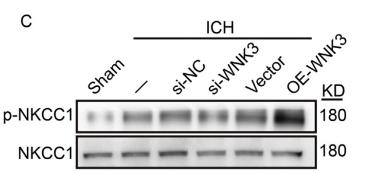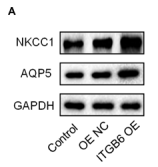SLC12A2 Antibody - #DF2245
| Product: | SLC12A2 Antibody |
| Catalog: | DF2245 |
| Description: | Rabbit polyclonal antibody to SLC12A2 |
| Application: | WB IHC |
| Cited expt.: | WB |
| Reactivity: | Human, Mouse, Rat |
| Prediction: | Pig, Zebrafish, Bovine, Horse, Sheep, Rabbit, Dog, Chicken, Xenopus |
| Mol.Wt.: | 130 kDa; 131kD(Calculated). |
| Uniprot: | P55011 |
| RRID: | AB_2839476 |
Related Downloads
Protocols
Product Info
*The optimal dilutions should be determined by the end user. For optimal experimental results, antibody reuse is not recommended.
*Tips:
WB: For western blot detection of denatured protein samples. IHC: For immunohistochemical detection of paraffin sections (IHC-p) or frozen sections (IHC-f) of tissue samples. IF/ICC: For immunofluorescence detection of cell samples. ELISA(peptide): For ELISA detection of antigenic peptide.
Cite Format: Affinity Biosciences Cat# DF2245, RRID:AB_2839476.
Fold/Unfold
Basolateral Na-K-Cl symporter; BSC; BSC2; Bumetanide-sensitive sodium-(potassium)-chloride cotransporter 1; mBSC2; MGC104233; NKCC1; PPP1R141; Protein phosphatase 1, regulatory subunit 141; S12A2_HUMAN; Slc12a2; sodium-potassium-chloride cotransporter 1; Solute carrier family 12 (sodium/potassium/chloride transporter), member 2; solute carrier family 12 (sodium/potassium/chloride transporters) member 2; Solute carrier family 12 member 2; sy-ns;
Immunogens
A synthesized peptide derived from human SLC12A2, corresponding to a region within the internal amino acids.
- P55011 S12A2_HUMAN:
- Protein BLAST With
- NCBI/
- ExPASy/
- Uniprot
MEPRPTAPSSGAPGLAGVGETPSAAALAAARVELPGTAVPSVPEDAAPASRDGGGVRDEGPAAAGDGLGRPLGPTPSQSRFQVDLVSENAGRAAAAAAAAAAAAAAAGAGAGAKQTPADGEASGESEPAKGSEEAKGRFRVNFVDPAASSSAEDSLSDAAGVGVDGPNVSFQNGGDTVLSEGSSLHSGGGGGSGHHQHYYYDTHTNTYYLRTFGHNTMDAVPRIDHYRHTAAQLGEKLLRPSLAELHDELEKEPFEDGFANGEESTPTRDAVVTYTAESKGVVKFGWIKGVLVRCMLNIWGVMLFIRLSWIVGQAGIGLSVLVIMMATVVTTITGLSTSAIATNGFVRGGGAYYLISRSLGPEFGGAIGLIFAFANAVAVAMYVVGFAETVVELLKEHSILMIDEINDIRIIGAITVVILLGISVAGMEWEAKAQIVLLVILLLAIGDFVIGTFIPLESKKPKGFFGYKSEIFNENFGPDFREEETFFSVFAIFFPAATGILAGANISGDLADPQSAIPKGTLLAILITTLVYVGIAVSVGSCVVRDATGNVNDTIVTELTNCTSAACKLNFDFSSCESSPCSYGLMNNFQVMSMVSGFTPLISAGIFSATLSSALASLVSAPKIFQALCKDNIYPAFQMFAKGYGKNNEPLRGYILTFLIALGFILIAELNVIAPIISNFFLASYALINFSVFHASLAKSPGWRPAFKYYNMWISLLGAILCCIVMFVINWWAALLTYVIVLGLYIYVTYKKPDVNWGSSTQALTYLNALQHSIRLSGVEDHVKNFRPQCLVMTGAPNSRPALLHLVHDFTKNVGLMICGHVHMGPRRQAMKEMSIDQAKYQRWLIKNKMKAFYAPVHADDLREGAQYLMQAAGLGRMKPNTLVLGFKKDWLQADMRDVDMYINLFHDAFDIQYGVVVIRLKEGLDISHLQGQEELLSSQEKSPGTKDVVVSVEYSKKSDLDTSKPLSEKPITHKVEEEDGKTATQPLLKKESKGPIVPLNVADQKLLEASTQFQKKQGKNTIDVWWLFDDGGLTLLIPYLLTTKKKWKDCKIRVFIGGKINRIDHDRRAMATLLSKFRIDFSDIMVLGDINTKPKKENIIAFEEIIEPYRLHEDDKEQDIADKMKEDEPWRITDNELELYKTKTYRQIRLNELLKEHSSTANIIVMSLPVARKGAVSSALYMAWLEALSKDLPPILLVRGNHQSVLTFYS
Predictions
Score>80(red) has high confidence and is suggested to be used for WB detection. *The prediction model is mainly based on the alignment of immunogen sequences, the results are for reference only, not as the basis of quality assurance.
High(score>80) Medium(80>score>50) Low(score<50) No confidence
Research Backgrounds
Electrically silent transporter system. Mediates sodium and chloride reabsorption. Plays a vital role in the regulation of ionic balance and cell volume.
Membrane>Multi-pass membrane protein.
Expressed in many tissues.
Belongs to the SLC12A transporter family.
Research Fields
· Human Diseases > Infectious diseases: Bacterial > Vibrio cholerae infection.
· Organismal Systems > Digestive system > Salivary secretion.
· Organismal Systems > Digestive system > Pancreatic secretion.
References
Application: WB Species: Rat Sample: brain tissue
Application: WB Species: Human Sample: NAFLD
Application: WB Species: yaks Sample: lungs
Application: WB Species: Human Sample:
Restrictive clause
Affinity Biosciences tests all products strictly. Citations are provided as a resource for additional applications that have not been validated by Affinity Biosciences. Please choose the appropriate format for each application and consult Materials and Methods sections for additional details about the use of any product in these publications.
For Research Use Only.
Not for use in diagnostic or therapeutic procedures. Not for resale. Not for distribution without written consent. Affinity Biosciences will not be held responsible for patent infringement or other violations that may occur with the use of our products. Affinity Biosciences, Affinity Biosciences Logo and all other trademarks are the property of Affinity Biosciences LTD.







